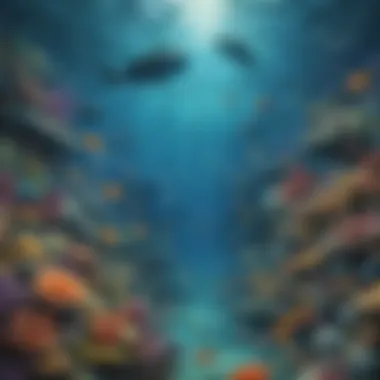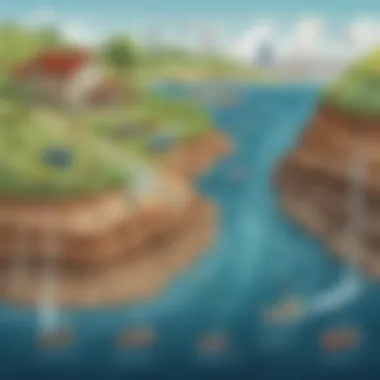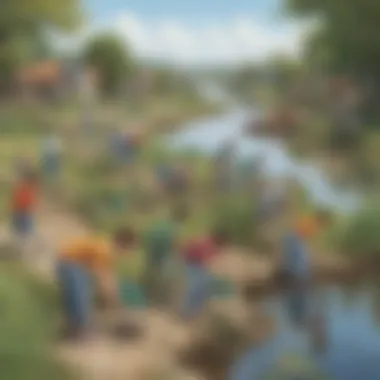Preventing Water Pollution: A Guide for Young Scientists


Intro
Water pollution is a pressing concern affecting all of us. For young science enthusiasts, it is crucial to grasp not only what water pollution is, but also its sources and effects on the planet. This understanding can spark a commitment to protecting our environment.
As children aged six to twelve explore this guide, they will discover why clean water is essential for life and health. Whether through learning about the chemicals in contaminated water or investigating the local waterways, every piece of this puzzle sets the stage for informed action. The journey ahead promises to be filled with knowledge, offering them ways to contribute to pollution prevention in their own communities.
With this foundation, let's move on to exciting and informative facts about water pollution that can enhance your understanding and spark curiosity about science.
Science Fun Facts
Understanding the facts about water pollution may feel like unraveling a complex mystery. Let's break it down in a fun and memorable way.
Interesting Trivia and Facts
- The Great Pacific Garbage Patch: It is a massive area in the ocean where plastic waste collects, making it a stark example of water pollution.
- Freshwater Sources: Only about 2.5% of all the water on Earth is freshwater, and pollution can harm this limited resource.
Quirky Science Stories
One curious story from the past involves the water quality in London in the 1850s. The city's habit of dumping waste into the River Thames led to a severe health crisis. Life-threatening diseases broke out, forcing people on the decision to clean their river and improve public health through better sanitation practices.
Amazing Science Records
Did you know the longest river in the world is the Nile, which flows for about 4,135 miles? Sadly, many rivers around the world are facing pollution challenges that endanger their health and those that rely on them.
Thought-Provoking Questions
- What small steps can we take in our daily lives to reduce water pollution?
- How do pollution levels in nearby water sources impact animals and ecosystems?
Through these facts and questions, young readers can appreciate both the urgency and the actions that can be taken to make a change. Next, we’ll dive deeper into the wonders we can explore through real science concepts and how they apply directly to water pollution.
Understanding Water Pollution
Understanding water pollution is essential for young science enthusiasts. This knowledge equips them with the insight needed to appreciate the delicate equilibrium that exists in our ecosystems. When children comprehend what water pollution is, they recognize its repercussions on the environment and human health. This awareness fosters a sense of responsibility toward protecting water sources.
Water is a fundamental resource, crucial for life on Earth. Knowing how to identify and prevent pollution helps ensure this vital resource remains clean and accessible. Additionally, understanding water pollution opens doors to investigating related scientific topics such as chemistry, biology, and environmental science. Furthermore, as younger generations learn about these issues, they become more inclined to advocate for change in their communities.
Definition of Water Pollution
Water pollution occurs when harmful substances contaminate bodies of water such as rivers, lakes, and oceans. This contamination can result from various sources including chemicals, waste, and pathogens. Even small amounts of pollutants can have major impacts over time, disrupting aquatic life and making the water unsafe for drinking and recreational use.
The pollutants can take different forms, such as:
- Chemical Compounds: These include pesticides, heavy metals, and fertilizers that enter water through runoff or direct discharge.
- Microorganisms: Pathogens can come from sewage or animal waste, posing serious health risks.
- Physical Debris: Items like plastic waste, glass, and other trash not only pollute but also endanger marine animals.
Understanding these elements is key to recognizing how each contributes to the overall issue of water pollution.
Historical Context of Water Pollution
The issue of water pollution is not new. Historically, societies have relied on rivers and lakes for transportation, drinking water, and waste disposal. Ancient civilizations often polluted fresh water sources without understanding the long-term implications. For instance, during the Roman Empire, wastewater was dumped directly into the Tiber River, one of the main water sources.
In the modern era, industrialization played a significant role in exacerbating water pollution. Factories began discharging chemicals into rivers, severely affecting water quality. This led to many public health crises, prompting governments to take action. The late 20th century saw the introduction of environmental regulations intended to control and reduce water pollution.
Understanding this history is crucial for young minds. It helps them appreciate the need for regulations and encourages them to participate in the current efforts aimed at protecting water resources. Through the knowledge gained about past mistakes, they can learn to advocate for sustainable practices that protect our water from future pollution.
Main Sources of Water Pollution
Understanding the main sources of water pollution is crucial for addressing this prominent environmental issue. Each source contributes differently to water degradation, affecting not just aquatic life but also human health and economic stability. Recognizing these sources allows young science enthusiasts to grasp the multidimensional aspects of water pollution. They learn where intervention is needed, and how their actions can brilliantly lead to change.


Industrial Discharges
Industrial discharges represent a significant source of water pollution. Factories require water for various processes, and often, this water becomes contaminated with chemicals and waste. When discharged improperly, these contaminants enter rivers, lakes, and oceans, disrupting ecosystems.
The implications for aquatic ecosystems can be substantial:
- Chemical compounds may harm native species.
- Overloading water bodies with toxins can lead to eutrophication, where excessive nutrients harm water quality.
Examples include heavy metals and solvents, common in manufacturing settings. With educated awareness, children can appreciate how regulation and proper practices in industries are vital for cleaner water.
Agricultural Runoff
Agricultural runoff also plays a significant role in water pollution. Fertilizers and pesticides are used extensively to enhance crop yield. Rainfalls and irrigation can cause these chemicals to wash down into nearby streams and lakes. This runoff is rich in nutrients, leading to issues similar to industrial discharge.
Key points related to agricultural runoff are:
- Increased levels of nitrates and phosphates in water bodies.
- Encouragement of harmful algal blooms that can produce toxins harmful to both humans and animals.
By understanding these connections, young enthusiasts can advocate for sustainable agricultural practices.
Household Wastewater
Household wastewater makes up a considerable portion of water pollution. Everything from soap and detergents to waste is washed down in sinks and toilets. In many places, wastewater treatment is essential to clean this water before it returns to the environment.
Common concerns include:
- Bacteria and viruses may enter wastewater systems, posing health risks.
- Improper disposal of non-biodegradable materials leads to added stress on treatment facilities.
Learning about the importance of proper disposal methods can empower youngsters to take action, and or encourage their families to adopt better habits.
Plastic Pollution
Plastic pollution has reached alarming levels in water bodies across the globe. Discarded plastic products gradually break down into microplastics, affecting even the most remote marine areas. Wildlife can ingest or become entangled in plastic debris, leading to injury or death.
Significant factors for children to consider:
- Microplastics can enter the food chain, impacting what we eventually consume.
- Awareness around the linked-global dilemma of single-use plastics and garbage disposal.
Encouraging proper recycling habits can pave the way for mitigating this pollution.
Oil Spills
Oil spills are another severe source of water pollution, often resulting from tanker accidents or drilling operations. The resultant contamination can devastate entire ecosystems, impacting wildlife and valuable habitats.
The effects of oil spills are dire:
- Immediate mortality of marine life.
- Long-term ecological impacts leave areas less capable of recovery.
Understanding the dramatic consequences of oil spills allows children to grasp the fragility of aquatic environments and the necessity of safety regulations.
In overcoming these challenges, young minds must embody stewardship, recognize their place within ecosystems, and spread awareness across their communities.
Impact of Water Pollution
Understanding the impact of water pollution is crucial for young science enthusiasts. Water pollution conveys serious implications for the world and all living things. An insight into these impacts creates awareness of our actions and helps us to recognize the vital role we play in protecting our environment. Every individual has the potential to affect the dynamics of water ecosystems, and this section explores their interconnectedness.
Effects on Aquatic Life


Aquatic life is directly affected by water pollution. Fish, plants, and microorganisms all face threats from contaminated water sources. Pollutants can enter the water through various sources like agricultural runoff or industrial discharges. Toxic substances, such as heavy metals or chemicals, harm aquatic organisms and disrupt their growth and reproductive cycles.
Moreover, pollutants like excess nutrients lead to conditions such as hypoxia, where oxygen levels in the water become dangerously low. Animals like fish and other marine creatures struggle to survive in such environments. Biologically diverse ecosystems suffer greatly when essential species diminish or become extinct due to pollution. Therefore, understanding these effects adds value to the protective measures we adopt.
Consequences for Human Health
Water pollution also poses significant risks to human health. When we consume contaminated water or consume organisms from polluted habitats, harmful pathogens may enter our bodies. This can result in serious illnesses affecting various parts of the body, including the gastrointestinal and respiratory systems.
Drinking water contaminated with pathogens, chemicals, or heavy metals can lead to long-term health issues. Children are often more vulnerable, presenting complications such as developmental delays or various health conditions. Elevating this awareness underscores our collective responsibility to ensure the cleanliness of our water sources.
Economic Impact
The economic fallout from water pollution is profound, gauGING various industries. Dirty water supplies increase treatment costs for households and industries alike. When the waterways are polluted, they are less capable of supporting recreational activities such as fishing, boating, or swimming. Additionally,Fishing industries suffer becuase state regulations might limit catch amounts in polluted areas.
The tourism sector also endures when visitors avoid polluted beaches or waterways. Furthermore, pollution cleanup requires substantial financial resources, diverting funds from vital services and community development. Raising awareness about these economics can help propel policy changes and foster more conscious habits in day-to-day aACTivities.
Protecting water resources is not just an environmental sacrIce; it is an investment in health and the economy.
In sum, the effects of zarious elements of water pollution reach wide ranging impacts affecting life and livelihoods. Teaching ourselves and others helps to generate steadfast rules for respect and protection of this critical asset–clean water.
Preventing Water Pollution
Water pollution is a pressing modern-day dilemma that affects humanity, ecosystems, and biodiversity. The pollution of water sources compromises our health and damages habitats. To counter this, everyone, including young science enthusiasts, can take proactive measures to prevent water pollution. Focusing on personal responsibilities, community involvement, and education is vital. In addition to the benefits that extend beyond two short fishing trips, safeguarding our aquatic environments means a more amenable world for current and future generations.
Personal Actions
Proper Waste Disposal
Proper waste disposal is crucial for preventing water pollution. When trash is disposed of incorrectly, it often ends up in bodies of water. This litter can harm marine life and pollute accessible water resources. A key aspect of proper waste disposal is sorting garbage correctly. This method reduces waste that could slip into the waterways, preserving their health. For young readers, learning to throw away poainters and food waste correctly empowers them to particpate actively in encouraging cleaner lakes, rivers, and ocean.
Avoiding Single-Use Plastics
Single-use plastics present significant danger to water systems. Items such as straws, bags, and bottles contribute substantially to ocean and river pollution. Choosing reusable alternatives is a smart move. One appealing aspect of avoiding single-use plastics is the tangible reduction of waste generated. Though sometimes seen as a privacy invasion, water quality maintains integrity when people reduce plastic use. Many schools and towns have implemented programs to engage in this change, exemplifying the movement toward friendly consuming.
Conserving Water
Conserving water plays a role in preventing pollution as well. Less water usage means fewer fertilizers and chemicals running into the watershed. Simple practices like turning off the tap when brushing teeth or taking shorter showers can significantly lessen pollution. Conserving water helps in the fight against water contamination and saves money on water bills. The common practice empowers everyone around to also cherish their precious rainfall. Students can lead conservation initiatives and pressure their families and schools to initiate similar programs.
Community Involvement
Participating in Clean-up Events
Engaging in local clean-up events generates remarkable results in protecting the environment. These activities involve groups collecting litter from nearby lakes, rivers, or beaches. A unique quality of clean-up efforts is communication. Young participants get to know peers and collaborate toward a shared goal. However, it is essential to ensure tools and excap for safety. Joining local clean-up initiatives will link students' actions directly to improvements in local environments.
Advocating for Local Regulations
Advocating for suitable local regulations signifies intentional action against pollution. Young enthusiasts can encourage their community to pass cleaner regulations for businesses and households. In this aspect, local governments can implement guidelines on waste handling and emissions. Learning about political engagement empowers youth by teaching them respect for biosystems and governance matters. Vsualize a cleaner neighborhood alongside group works to spotlight urgent environmental changes needed.
Educating Others
Education is essential for fighting water pollution. Kids can represent hope through sharing knowledge of waterways with peers and adults. Discussions around the importance of clean water starts a dheeming dialogue in any social setting. For instance, they can host awareness events or create digital content describing daily practices that polluted shared habitats. Detecting knowledgeable children always catalysis motivational effects.
Visual communicating informative ideas to families ensures that prevention keeps a steady cooperate flow.
The Role of Regulations and Policies
Water pollution is not just a pressing environmental concern but also a multifaceted challenge that requires regulation and proactive policies. These frameworks are vital in governing human activities impacting water quality. Young science enthusiasts can understand that laws and international agreements serve as guidelines. They motivate individuals, corporations, and governments toward a shared goal: cleaner water. Furthermore, these regulations can control pollution at the source, preventing it from entering ecosystems.


Environmental Protection Laws
Environmental protection laws are foundational in combating water pollution. They offer a legal backbone to ensure that practices harmful to water bodies are regulated or abolished. These laws typically involve setting quality standards for water. They help identify pollutants and limit harmful waste disposal in rivers, lakes, and oceans. Also, such laws outline consequences for non-compliance. For otimize results, communities often participate in setting these regulations based on local needs. Examples of these laws include the Clean Water Act in the United States and the European Water Framework Directive.
Aside from penalties, education plays a key role. Often new laws come with campaigns that explain the importance of water conservation to both citizens and businesses. Policies can encourage technological innovations. Companies are more likely to develop cleaner processes when they know the stakes involve scrutiny from regulatory bodies. Environmental protection laws not only act as barriers, but they also pave the road for sustainable practices.
Global Agreements on Water Pollution
Addressing water pollution requires collective global effort. Various countries collaborate through treaties and agreements aimed to tackle water quality issues Transnational matters demand agreement since pollutants easily make their way across borders. Global efforts like the United Nations Sustainable Development Goals have identified clean water and sanitation as a goal requiring worldwide action.
Another significant example is the Convention on the Protection and Use of Transboundary Watercourses. The agreement assists countries in managing shared water resources, harmonizing national policies. By highlighting the importance of shared water bodies, it encourages cooperation and promotes clean water standards.
Young activists can understand the weight of these agreements. They foster accountability among nations, pushing countries not only to uphold their commitments but to innovate solutions to ongoing pollution issues. Policies create a collective vision, binding various stakeholders to contribute toward cleaner, healthier water.
The necessity for collaborative, legislative strategies in the fight against water pollution is evident. Each action at the local and international levels echoes through ecosystems, impacting lives today and in the future.
Future Consequences if Water Pollution Isn't Addressed
Water pollution is not just an immediate problem; it has consequences that will ripple through future generations. Understanding these risks is essential for young science enthusiasts. Addressing water pollution today can help prevent bigger issues down the line, thereby contributing to a healthier planet.
Projected Environmental Changes
If water pollution continues without intervention, several environmental changes are predicted. Aquatic habitats could significantly deteriorate. For example, many fish species may find it difficult to survive in polluted waters, resulting in imbalanced ecosystems. Wetlands, which naturally purify water, might face degradation, which limits their ability to filter harmful substances. The loss of biodiversity is a serious concern that stems from water pollution.
Additionally, climate change could be exacerbated by water pollution. Rivers and lakes act as natural carbon sinks. When they are polluted, not only does this property diminish, but unfettered waste contributes to greenhouse gas emissions from water bodies.
In essence, the future may hold:
- Declines in fish populations, affecting food chains
- Increased toxic algal blooms, making water unsafe for drinking and recreation
- Loss of wetlands leading to more flooding and less biodiversity
Social and Economic Ramifications
Ignoring water pollution also has far-reaching social and economic effects. According to recent studies, the costs of treating polluted water can be monumental. Governments may need to spend more to clean up contaminated sources, creating a strain on public resources.
220 million school days are missed each year due to water-related illnesses caused by contaminated water. Waterborne diseases afect both individual health and public health systems. Parents and communities might find heavier emotional and financial burdens associated with healthcare costs.
From an economic perspective, industries like fisheries and tourism can suffer significant losses. Families may be impacted if they rely on these industries for income. Areas well-known for fishing or outdoor water-based activities might see fewer visitors if local waters are polluted.
Important points to consider include:
- Economic losses in fishing and tourism sectors
- Health care costs from pollution-related illnesses
- Increased funding needed for wastewater treatment facilities
“The far-reaching effects of water pollution go beyond our immediate perception; they encompass critical environmental and socioeconomic dimensions.”
The End
Water pollution is a pressing issue that requires attention and collective efforts to address. Nature provides us with essential resources like clean water, and the degradation of water sources impacts both the environment and our health.
The Importance of Collective Action
Much of the work to prevent water pollution cannot be achieved by individuals alone. Thus, collective action is vital. By working together, communities can implement programs that tackle pollution on a larger scale. For example:
- Organizing community clean-ups: Schools can host programs to clean local rivers, lakes, or beaches. This helps to raise awareness while maintaining local water sources.
- Advocating for stricter regulations: Young people can engage with local officials, expressing the need for laws that protect water sources. This not only promotes awareness but also fosters responsibility among peers.
It is crucial for young science enthusiasts to recognize their role and potential impact within their communities. Teaching others about these practices encourages active participation in water pollution prevention. Collective action can amplify voices. It allows each contribution, no matter how small, to be really important when striving for positive change.
Encouraging a Sustainable Future
Looking ahead, the fight against water pollution has considerable implications for a sustainable future. Each generation has the responsibility to foster an environment where water sources can thrive. Parents, teachers, and caregivers can support youngsters by introducing sustainable practices, such as:
- Promoting water-saving techniques: Simple actions, like fixing leaks and utilizing less water when brushing teeth, teach efficient water use.
- Educating about recycling and disposal: Children can learn how to sort waste and understand the impact of pollutants entering waterways.
"Taking even small steps toward environmental stewardship today can lead to significant changes for our water sources tomorrow."
Encouraging enthusiasm for science can develop into a continue commitment to preserving environmental health. The goal is to nurture informed citizens who appreciate nature and act thoughtfully.







